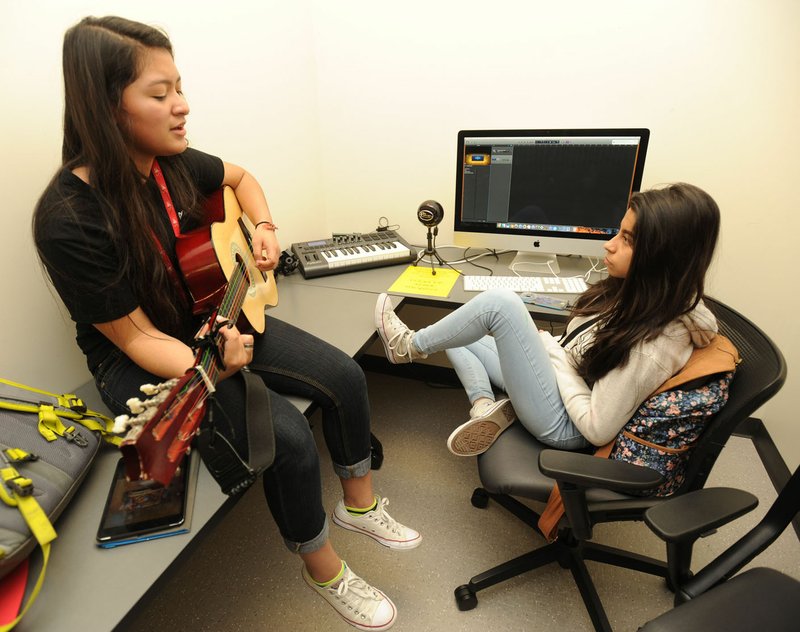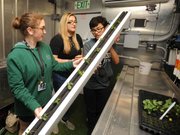SPRINGDALE -- School District leaders envision the possibility of sixth- and seventh-graders joining eighth- through 12th-graders at the Tyson School of Innovation.
Architects have developed a floor plan for a 150,000-square-foot addition to the east side of the campus opened this school year on Hylton Road.
Elementary libraries
School Board members on Tuesday also saw plans for new library media centers at Tyson and Walker elementary schools for $1.5 million each. The new space at Tyson will give the campus a more pronounced entrance on the front of Tyson, Deputy Superintendent Jared Cleveland said. “It will give you the sense the whole school is new,” Cleveland said.
The addition at Walker will sit on the northwest corner and connect to the school cafeteria, said Brad Chilcote of Little Rock-based Wittenburg, Delony & Davidson Architects.
The projects will change the exteriors of the buildings to have glass similar to the design of the Tyson School of Innovation, Chilcote said.
— Staff Report
Rollins and members of his administrative team shared greater detail about the possible expansion during a work session Tuesday before the School Board meeting.
The School Board hasn't made a decision about whether to proceed, and Rollins anticipates further discussion at the board's May meeting.
Savings from refinancing debt will provide $10 million that could be put toward the $30 million project, Rollins said. District officials think money from the Arkansas Division of Public Schools Academic Facilities and Transportation will amount to $14.9 million, leaving a gap of about $5 million.
"That's a pretty special opportunity," Rollins said. "We're thinking about it. We're looking at it."
The School of Innovation opened at the Jones Center in 2014 with about 200 eighth-graders and emphasizes integrating of science, technology, engineering and math. The student body has grown to about 500 eighth- through 10th-graders who have flexible schedules and the ability to learn at their own pace.
The School of Innovation over the next two years will accommodate 11th- and 12th-graders. It also provides options for virtual education.
The School District will know for certain how much state money will be available for a possible expansion of the School of Innovation on May 1, Deputy Superintendent Jared Cleveland said.
If the district proceeds, the design phase would be this year, Cleveland said. Construction could begin in 2020 with the addition finishing in 2021.
The attention to expanding the school s driven by many factors, including state money availability, the increasing number of options students have for public or private education and growing student bodies at Har-Ber and Springdale high schools, Rollins said. The middle school focus on group learning fits with the School of Innovation model.
The district's two traditional high schools have about 2,265 and 2,170 students, Rollins said. Rollins doesn't want enrollments in those campuses to grow to 2,400 or more students. The School of Innovation acts as a "relief valve," he said.
And if the district loses a student to another school, such as a charter or private school, in the seventh grade, Rollins thinks the district probably has lost that student, he said.
"We have to compete for families, for students," Rollins said. "If students are considering through the choice avenues other venues, we need to connect with those kids before they make that option to go somewhere else."
School Board President Randy Hutchinson said he'll continue to study the options for the school, but the plans would provide families with the option of their child attending one school for kindergarten through fifth grade and another school for sixth through 12th grade.
State money is paid per student, and for Springdale, the loss of students to charter and private schools can add up to several million dollars, Hutchinson said.
Haas Hall Academy, an open-enrollment charter school, is set to open a new campus for as many as 500 seventh- through 12th-graders at the Jones Center. The Springdale site will begin with the seventh through 10th grades in the fall.
The district also faces competition from Ozark Montessori Academy, another open-enrollment charter school expanding, and from private schools including Shiloh Christian School and Providence Classical Christian Academy, Hutchinson said.
"I'm excited about the whole thing," he said. "We want to do what we can to keep kids in our district."
The opportunity for a sixth- or seventh-grader to attend the School of Innovation is an "awesome opportunity," School Board member Michelle Cook said. She also knows some parents will want reassurance their younger students will not be in classes with 12th-graders, she said.
The idea of expanding is an ongoing conversation, Cleveland said.
"It's a critical decision," Cleveland said. "We're talking about district dollars that could potentially take away from other potential needs. We're not just one school. We're trying to invest in every opportunity for students."
Cleveland also knows of students in the district who would benefit from the options available through the School of Innovation, he said.
"What do we do to stay relevant, to compete and push those higher kids?" he said.
NW News on 04/12/2017


